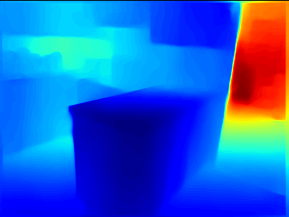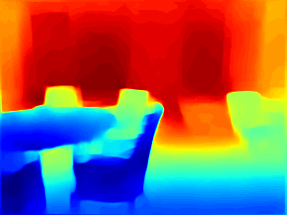Here, we propose an approach that integrates learning low level and high level features to estimate high-quality depth maps from single-view 2-D images
A deep fully convolutional architecture and suitable optimization objectives that minimize a set of per-pixel loss functions and a perceptual loss function, along with augmentation and training strategies has been employed.
| Input RGB Image | Ground truth depth map | Our results |
|---|---|---|
 |
 |
 |
 |
 |
 |
| 0.852 | 0.976 | 0.995 | 0.122 | 0.500 | 0.053 |
Installation
To install, execute
pip install -r requirements.txt
Data
NYU Depth v2 train - (50K images) (4.1 GB)
On extraction, there will be a data folder.
NYU Depth v2 test - (654 images) (1 GB)
On extraction, there will be three .npy files.
Training
The script train.py contains the code for training the model. It can be invoked with the following arguments:
usage: train.py [-h] --train_dir TRAIN_DIR --test_dir TEST_DIR --batch_size
BATCH_SIZE --checkpoint_dir CHECKPOINT_DIR --epochs EPOCHS
[--checkpoint CHECKPOINT] [--lr LR]
[--log_interval LOG_INTERVAL] [--backbone BACKBONE]
[--test_batch_size TEST_BATCH_SIZE]
[--perceptual_weight PERCEPTUAL_WEIGHT]
Training of depth estimation model
-h, --help show this help message and exit
mandatory arguments:
--train_dir TRAIN_DIR
Train directory path - should contain the 'data'
folder
--test_dir TEST_DIR Test directory path - should contain 3 files
--batch_size BATCH_SIZE
Batch size to process the train data
--checkpoint_dir CHECKPOINT_DIR
Directory to save checkpoints in
--epochs EPOCHS Number of epochs
optional arguments:
--checkpoint CHECKPOINT
Model checkpoint path
--lr LR Learning rate
--log_interval LOG_INTERVAL
Interval to print the avg. loss and metrics
--backbone BACKBONE Model backbone: densenet161 or densenet121
--test_batch_size TEST_BATCH_SIZE
Batch size for frequent testing
--perceptual_weight PERCEPTUAL_WEIGHT
Weight for the perceptual loss
It is advised to run the code on a GPU. The code automatically detects if a GPU is available, and uses it.
Evaluation/Inference
The script evaluate.py contains the code for evaluating the model/for predicting the depth given an image. It can be invoked with the following arguments:
usage: evaluate.py [-h] --model MODEL [--data_dir DATA_DIR] [--img IMG]
[--batch_size BATCH_SIZE] [--output_dir OUTPUT_DIR]
[--backbone BACKBONE]
Evaluation of depth estimation model on either test data/own images
-h, --help show this help message and exit
arguments:
--model MODEL Model checkpoint path
--data_dir DATA_DIR Test data directory(If evaluation on test data)
--img IMG Image path(If evaluation on a single image)
--batch_size BATCH_SIZE
Batch size to process the test data
--output_dir OUTPUT_DIR
Directory to save output depth images
--backbone BACKBONE Model backbone - densenet 121 or densenet 161
It is advised to run the code on a GPU. The code automatically detects if a GPU is available, and uses it.
Please cite the following if you find the code useful in your research:
@misc{Ashok2020,
author = {Ashok, Arjun},
title = {Perceptual Dense Network for High-Quality Monocular Depth Estimation},
year = {2020},
publisher = {Zenodo},
doi = {10.5281/zenodo.4041690},
version = {1.0},
url = {https://doi.org/10.5281/zenodo.4041690}
}

